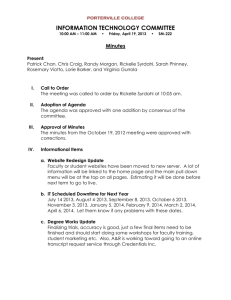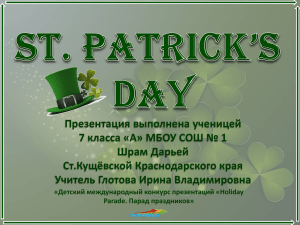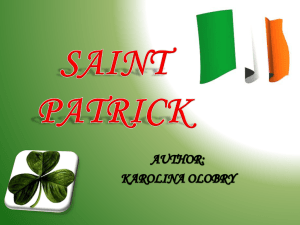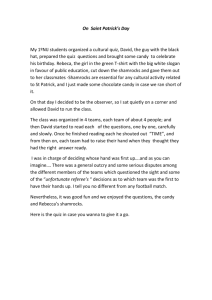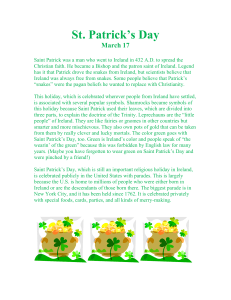St Patrick Notes (Senior Cycle)
advertisement
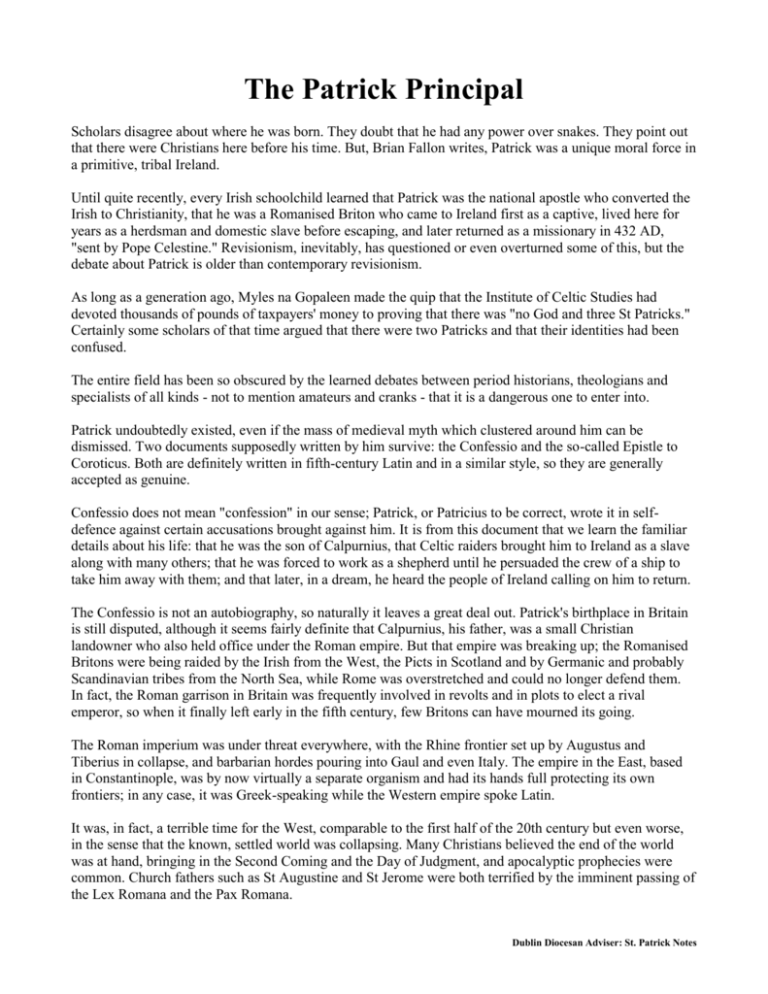
The Patrick Principal Scholars disagree about where he was born. They doubt that he had any power over snakes. They point out that there were Christians here before his time. But, Brian Fallon writes, Patrick was a unique moral force in a primitive, tribal Ireland. Until quite recently, every Irish schoolchild learned that Patrick was the national apostle who converted the Irish to Christianity, that he was a Romanised Briton who came to Ireland first as a captive, lived here for years as a herdsman and domestic slave before escaping, and later returned as a missionary in 432 AD, "sent by Pope Celestine." Revisionism, inevitably, has questioned or even overturned some of this, but the debate about Patrick is older than contemporary revisionism. As long as a generation ago, Myles na Gopaleen made the quip that the Institute of Celtic Studies had devoted thousands of pounds of taxpayers' money to proving that there was "no God and three St Patricks." Certainly some scholars of that time argued that there were two Patricks and that their identities had been confused. The entire field has been so obscured by the learned debates between period historians, theologians and specialists of all kinds - not to mention amateurs and cranks - that it is a dangerous one to enter into. Patrick undoubtedly existed, even if the mass of medieval myth which clustered around him can be dismissed. Two documents supposedly written by him survive: the Confessio and the so-called Epistle to Coroticus. Both are definitely written in fifth-century Latin and in a similar style, so they are generally accepted as genuine. Confessio does not mean "confession" in our sense; Patrick, or Patricius to be correct, wrote it in selfdefence against certain accusations brought against him. It is from this document that we learn the familiar details about his life: that he was the son of Calpurnius, that Celtic raiders brought him to Ireland as a slave along with many others; that he was forced to work as a shepherd until he persuaded the crew of a ship to take him away with them; and that later, in a dream, he heard the people of Ireland calling on him to return. The Confessio is not an autobiography, so naturally it leaves a great deal out. Patrick's birthplace in Britain is still disputed, although it seems fairly definite that Calpurnius, his father, was a small Christian landowner who also held office under the Roman empire. But that empire was breaking up; the Romanised Britons were being raided by the Irish from the West, the Picts in Scotland and by Germanic and probably Scandinavian tribes from the North Sea, while Rome was overstretched and could no longer defend them. In fact, the Roman garrison in Britain was frequently involved in revolts and in plots to elect a rival emperor, so when it finally left early in the fifth century, few Britons can have mourned its going. The Roman imperium was under threat everywhere, with the Rhine frontier set up by Augustus and Tiberius in collapse, and barbarian hordes pouring into Gaul and even Italy. The empire in the East, based in Constantinople, was by now virtually a separate organism and had its hands full protecting its own frontiers; in any case, it was Greek-speaking while the Western empire spoke Latin. It was, in fact, a terrible time for the West, comparable to the first half of the 20th century but even worse, in the sense that the known, settled world was collapsing. Many Christians believed the end of the world was at hand, bringing in the Second Coming and the Day of Judgment, and apocalyptic prophecies were common. Church fathers such as St Augustine and St Jerome were both terrified by the imminent passing of the Lex Romana and the Pax Romana. Dublin Diocesan Adviser: St. Patrick Notes Europe's Dark Ages were beginning, which lasted until Charlemagne's time at least, and Christianity was left as the only moral or civil force which could hold the civilised world together. Ireland was out on the European periphery, a kind of Ultima Thule or Land of the Hyperboreans which had never been conquered or even invaded by Rome, though one Roman emperor had reckoned that a single legion - from 6,000 to 10,000 men - would be enough for the job. In Patrick's time, Ireland's population was probably anything from 200,000 to half a million, though there were also Irish settlements in Wales and in what are now Devon and Cornwall, as well as the large Irish presence north of Hadrian's Wall which grew into the kingdom of Dal Riata. (The Scots take their name from the Irish, who were then called Scoti or Scotti by the Roman world). Ireland was not so "dark" as is sometimes stated - Ptolemy, the Alexandrian Greek geographer who lived and wrote in the second century AD, knew a certain amount about it, though at second hand. It had no towns as such and was a completely rural ecomony, though raiding into Britain and Gaul had become a profitable industry, both in slaves and in household booty. But it also had some legitimate trade with the Continent (Irish hunting dogs were famous) and was less isolated culturally than is often said. Contrary to what was accepted for many centuries, it probably had Christian communities, or at least Christian believers, well before St Patrick arrived. The number of British and Gaulish captives alone would have guaranteed that, but the constant coming and going between Ireland and the Continent, and between Ireland and Christianised Britain, would surely have produced religious and cultural interchange. The vague, animistic religion(s) or cults which existed in Ireland offered little concerted resistance to the new faith, nor were the Druids the fanatical witch-doctors of later legend. Palladius, the first Irish bishop, arrived in 431 AD and he, whatever about Patrick, certainly was sent by Celestine. Other helpers or successors soon arrived - Secundinus, Auxilius, Iserninus etc. But when did Patrick arrive, then? The answer is: probably later than the long-accepted date of 432. Liam de Paor, in his important book St Patrick's World, shows that such a date is essentially later propaganda intended to give Patrick a unique, pre-eminent role as the great Irish apostle. This was because in the seventh century the ambitious See of Armagh was pushing hard for primacy, and the image of Patrick which it created was part of its propaganda campaign. De Paor believes that he did not arrive before the mid-century - not until about 460 AD, perhaps. He places Patrick's birth about 415 and since he was brought to Ireland at 16 and was kept there for six years, he probably escaped about 437. After that he probably spent some years in Gaul, before being ordained a deacon, then a priest, and finally a bishop. It was in this last capacity that he returned from Britain to Ireland, and it was unlikely that he came as a missionary in the usual sense. The primary duties of a bishop were to minister to an existing community, rather than to venture among dangerous heathen. His bishopric was probably in the north-east, among the Ulaid who have given their name to Ulster. Here his name was reverenced for centuries and the See of Armagh has always claimed to be in direct line of his succession. But he was still drawn powerfully to the West of Ireland, where he had probably been held prisoner years before - the stories linking him with Slemish in the north seem to be mostly invention, whereas the "wood of Foclut," which he mentions, is in Mayo. So if, in fact, he made the difficult and dangerous journey across Ireland to proselytise there, it explains the tone of the Confessio in which he answers various charges brought against him by senior clerics in Britain. He explains why he left his bishopric for a time in response to what he believed to be a direct, personal Dublin Diocesan Adviser: St. Patrick Notes imperative from God, and the money matters he mentions were probably connected with funding this mission. The Epistle to Coroticus was written to a British chieftain or petty king whose raiding soldiers had seized certain young Christians belonging to Patrick's flock, and taken them away as slaves. It was Patrick's own history repeated, though this time in reverse. It is an an angry letter of moral denunciation, written presumably in old age, though there is some indication that Patrick may have been still alive as late as 490 AD. The myths which grew up around him, of course, are endless. The symbolism of his driving out the snakes (something which Ireland never had) resembles the myth of St George slaying the dragon, symbolising paganism or the demons which Christians believed to underlie the ancient gods and their cults. In turn, this possibly derives from the old myth of the sun-god slaying the boar or sea-monster of winter, so delivering the land from dearth and cold. In any case, for centuries saints were popularly credited with the power of driving out demons, snakes, lizards, rats, even the plague. As for the shamrock, it seems that the Irish wore it as a symbol of the Cross - the old Tau Cross presumably, not the bare modern one - rather than of the Trinity. (Shamrock itself is simply immature trefoil, and the name is an anglicisation of seamair óg, "young clover.") Myths about saints are as prolific as myths about ancient heroes, and on average just as factual and reliable. The clergy of later ages seem to have had little scruple about writing down anything which came into their heads and suited them - they were creating myth-as-propaganda, not writing history, so a pious cause and the saving of souls justified it all. Obviously the more miracles they could invent in their hagiographies, the better - after all, the more impressive the miracles, the greater the saint. Credulous centuries swallowed them all and asked for more; in the Middle Ages "lives of the saints" became almost the equivalent of modern thrillers or TV serials, until they were largely ousted by the equally fantastic romances of chivalry which Cervantes burlesqued in Don Quixote. Yet in disposing of the inevitable myths and even the falsifying propaganda which later, self-interested ages created about him, we have not disposed of the real, intrinsic, historical Patrick. Over and above the arguments of scholars and theologians, something does come through of his mind and personality. The folk memory, after all, often has its own validity, and though St Patrick has not been commemorated by a single great sculpture or painting (and the songs about him are banal tunes fitted to drivelling words) ordinary Irish people are largely justified in regarding him as the national apostle. Palladius and his kind came here because they were sent, like colonial servants in the British Empire of eighty years ago, and they may well have regarded the Irish as outlandish barbarians; but Patrick came here mainly because he felt it was his vocation and lifework. He genuinely loved Ireland and its people, and of course he also spoke the native language, factors which must have made him a powerful preacher and a unique moral force in a relatively primitive, tribal society. So his adapted country has been right in taking him specially to its heart, while his predecessors and immediate successors have been virtually forgotten. We are justified in celebrating St Patrick's Day; who today lights a candle to Palladius? Dublin Diocesan Adviser: St. Patrick Notes The Saint of Hearts St Patrick in conversation with Medb Ruane - exclusive He looks like Santa Claus. Perched on a cloud over West Mayo, Patrick the lad from Carlisle could be anyone's granddad. Crinkly eyes and a smile that could melt an iceberg make him seem the kind of genial old man you'd see lighting up a pipe in North Kerry, or taking the train to Dublin for the All-Ireland Hurling Final. But appearances lie. This slave-turned-bishop is the exile who transformed a nation of warring Paddies into a land of saints and scholars. Yet he was never a glory-seeker. If Patrick's life reads like a Leon Uris novel, he's as surprised as anyone at the way it all turned out. How on earth did he become the patron saint of Ireland? "I've no idea," Patrick muses. "I was more than two centuries dead when they decided to resurrect me as some class of spiritual hero, and by that stage, well to be honest, I'd literally become part of the scenery. My soul was in heaven, of course, but my mortal remains had long since been - what's the word you use now? recycled back to the natural order." You can talk to Patrick only under the strictest conditions. "I can't intervene in the world's understanding of itself, or of me," he insists. "Anyway, there's been so many rows about who I am, or how many of me existed, that I long ago decided to keep my counsel about the whole shebang. But I want to nail some of the myths, particularly all that old guff Flann O'Brien called the "shamrocks and shenanigans and bullshit", if you'll pardon my French. You do know I spent time in France, don't you? " I do. In fact, scholars believed for years that he came from Gaul, and was living there with his family when he heard "the Voice of the Irish" calling out to him. Diplomatic though he undoubtedly is, Patrick questions their motives. "I wonder had the scholars a problem with my Britishness? My time in Gaul immediately preceded my ministry to the Irish, but I come from Britain, I'm proud to be British, although I wouldn't go so far as to embrace any racist notions about nationalism or tribal one upmanship. I see my work in a global context, and that's where I'd like to be placed." Born near Carlisle in or about 415, Patrick was captured by raiders at 16, and spent the next six years slaving for a master in the now-lost wood of Foclut, west of Killala - a once-rich agricultural area where the great pine forests of the Céide Fields had nurtured an earlier civilisation. He escaped to Gaul, probably took orders there and, though reunited with his family in Britain, became convinced that God was calling him to bring Christianity to those who had once oppressed him. His mission was a triumph, but his insistence on following his instincts led him into conflict with other elements in the Church. Like all mavericks, he attracted both envy and censure. A full investigation vindicated him, yet he still felt the need to defend himself in his own words. His Confessio is one of the few documents which survive from the 5th century. It's well worth reading. After his death, humanity intervened in Patrick's story, as humanity will. The need to invent a Christian hero prompted various well-intentioned obfuscations, not least of which was merging Patrick with the life of another missionary, Palladius. Until Professor Dan Binchy's brave article published in 1962, faith seemed Dublin Diocesan Adviser: St. Patrick Notes to obscure historical evidence, and challenges to the official canon were met with sometimes vicious opposition. Now, scholars such as Liam De Paor have articulated a clearer historical understanding of Patrick, and of the possible motives behind his transformation from radical missionary to single, authoritative saviour of Ireland. "Liam calls me `a lone voice from the 5th century,' and he's absolutely right. In those days, we did our best that was all there was to it. You couldn't be faxing Rome for instructions, or calling your bishop for permission to travel outside your own parish. All I had was my faith in God, and that's the voice I listened to." Patrick won't discuss Church politics, but he argues that earlier Irish scholars were blinded by nationalist perspectives in many issues surrounding his interpretation. He may be right. Although a symbol of Christianity in general rather than of any one branch in particular, his image became synonymous with some sectarian aspects of Irish nationalism, and thence as an indicator of Irish identity. For so long as he was appropriated by that class of nationalists, the rain poured down on every St Patrick's Day parade in Dublin. Patrick denies that he influenced the weather - "different orders of being, you can't mix the two: that clever young lad Aquinas explained it to me." How does he get on with Aquinas? Patrick becomes cautious. "Well you can put it this way. If we were at school together, he'd be head boy and I'd be the lad always sent to stand at the back of the class. Myself, I was never a scholar, so I never let theology worry me too much - I'm naive, unlettered, and very often foolish, that's why all this attention was so surprising." Humility apart - Patrick is wonderfully self-deprecating - he did have serious problems with his earlier image. "I won't condemn anyone, but I was unhappy being anyone's exclusive property. I included everyone. In my time, Christianity was an active agent for peace - that's what made it a radical, revolutionary force. "I negotiated with so many bloodthirsty Irish chieftains that I developed an eternity-long antipathy to militarism and all its trappings. Do you know I even had to pay what you'd call protection money to have their sons travel with me ? You never could be sure that they wouldn't turn on you." Now, the parade represents him as a giant puppet, a huge symbol of anarchic fun, more cartoon than spiritual innovator. Is that an improvement? "Piety and craic are great partners. The word here is that my image is changing all over again, so I suppose this is the first step on the new track, the new way of celebrating Irishness, with me - a Briton - as the main man. If I look like an elderly Bart Simpson, so much the better." Patrick did not expel the snakes from Ireland. "Don't push that one too far, the children all love me for that," he intervenes. He was not the first to bring Christianity to Ireland, and he has no desire to be lionised as a spiritual hero. He was not a misogynist, and blames his alleged punishing of sexual behaviour in women on over-eager scribes anxious to bring him into line with later Church teaching. "Look, for all they know, I could have been married myself - sure my grandfather was a married priest. We weren't so hung up on celibacy then, there were souls to be saved and that was our business." Patrick can't remember his exact date of death, but thinks it may have been around 493. Where are his mortal remains? He won't say, other than to confirm that he was not buried in Armagh. "I don't want to become a rotting relic, I hate those ghoulish shenanigans. Let people know that I, Patrick, prefer to see myself as a Saint of Hearts. A Saint of Hearts, mind. Be sure to write that down." Dublin Diocesan Adviser: St. Patrick Notes What did St Patrick ever do for us? 1. Without the Big Man we'd probably be stuck with St Eusebius or St Vitus for a patron saint. 2. No St Pat would mean no shamrock and it's such a dinky national symbol. It would also mean farewell to the lucrative shamrock trade and those fine footballers in the Shamrock Rovers. Perish the thought. 3. Without St Patrick there'd be no need for people to toil their way up Croagh Patrick ripping their feet to shreds on the rocks. And then what would we do for fun? 4. Imagine trying to think up names for hundreds of churches, cathedrals, national schools and streets. St Gubnait Cathedral? St Cyril hospital? They just don't have the same ring. 5. If St Patrick hadn't come up with the handy shamrock model to explain the holy Trinity we'd probably still be confused. Imagine the hoards of first communion candidates tossing and turning in their bunkbeds trying to work out this three-in-one thing - probably shampoo/conditioner combos would be used as an example instead. 6. An Post would probably go bust without the annual cash injection from St Patrick's day cards sent to Auntie Noreen in Tonga, Buddie in Djibouti and all those other far-flung relatives. 7. And then of course there's the snakes. Admittedly serpents are handy when manufacturing clutch handbags but not so good when frolicking in the fields or doing a spot of orienteering. 8. If St Patrick hadn't decided to bring Christianity to Ireland who knows whether anybody else would have bothered? We could be like those indigenous folk deep in the rainforest, worshipping a washed-up bottle of Coca-Cola. 9. No St Patrick, no St Patrick's Day parade and lord knows we need a bit of "divarsion" between Christmas and Easter. 10. Furthermore, no St Patrick means all those crazy yanks and other far-flung paddies would have no reason to drink green beer, wear shamrock-shaped spectacles or walk up to anyone who's passing and demand: "Kiss Me I'm Irish." Dublin Diocesan Adviser: St. Patrick Notes QUESTIONS Q.1. Who sent Patrick back to Ireland in 432 A.D.? Q.2. Name the two documents written by Patrick? Q.3. Why did Patrick write his ‘Confessio’? Q.4. Name St.Patrick’s father? Q.5. What event did many Christians believe was coming? Q.6. When did Europe’s Dark Ages end? Q.7. What was the population of Ireland during Patrick’s time? Q.8. Who was Ptolemy? Q.9. What were the Druids? Q.10. Who was the first Irish bishop? Q.11. When does Liam de Paor place Patrick’s birth? Q.12.Who was the Epistle to Coroticus written to? Q.13. What was the myth of St.George? Q.14. Why did the Irish wear Shamrock? Dublin Diocesan Adviser: St. Patrick Notes
